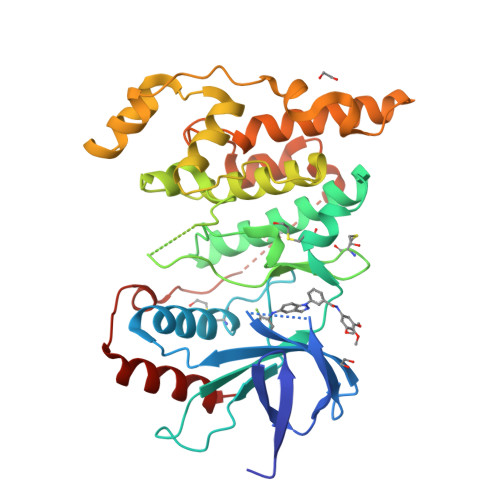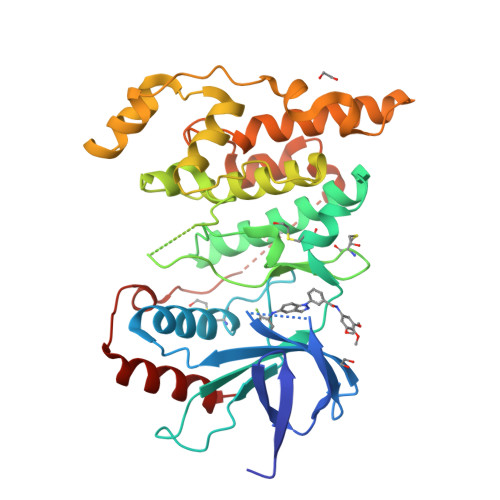Structure-activity relationships and X-ray structures describing the selectivity of aminopyrazole inhibitors for c-Jun N-terminal kinase 3 (JNK3) over p38.
Kamenecka, T., Habel, J., Duckett, D., Chen, W., Ling, Y.Y., Frackowiak, B., Jiang, R., Shin, Y., Song, X., LoGrasso, P.(2009) J Biological Chem 284: 12853-12861
- PubMed: 19261605
- DOI: https://doi.org/10.1074/jbc.M809430200
- Primary Citation of Related Structures:
3FI2, 3FI3 - PubMed Abstract:
c-Jun N-terminal kinase 3alpha1 (JNK3alpha1) is a mitogen-activated protein kinase family member expressed primarily in the brain that phosphorylates protein transcription factors, including c-Jun and activating transcription factor-2 (ATF-2) upon activation by a variety of stress-based stimuli. In this study, we set out to design JNK3-selective inhibitors that had >1000-fold selectivity over p38, another closely related mitogen-activated protein kinase family member. To do this we employed traditional medicinal chemistry principles coupled with structure-based drug design. Inhibitors from the aminopyrazole class, such as SR-3576, were found to be very potent JNK3 inhibitors (IC(50) = 7 nm) with >2800-fold selectivity over p38 (p38 IC(50) > 20 microm) and had cell-based potency of approximately 1 microm. In contrast, indazole-based inhibitors exemplified by SR-3737 were potent inhibitors of both JNK3 (IC(50) = 12 nm) and p38 (IC(50) = 3 nm). These selectivity differences between the indazole class and the aminopyrazole class came despite nearly identical binding (root mean square deviation = 0.33 A) of these two compound classes to JNK3. The structural features within the compounds giving rise to the selectivity in the aminopyrazole class include the highly planar nature of the pyrazole, N-linked phenyl structures, which better occupied the smaller active site of JNK3 compared with the larger active site of p38.
Organizational Affiliation:
Department of Molecular Therapeutics and Translational Research Institute, The Scripps Research Institute, Jupiter, FL 33458, USA.



















